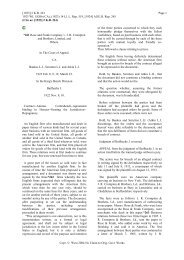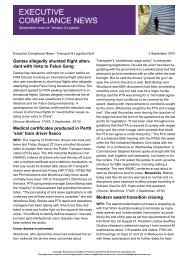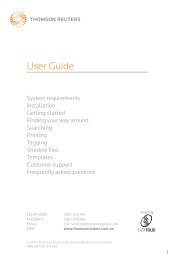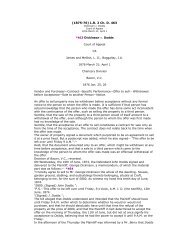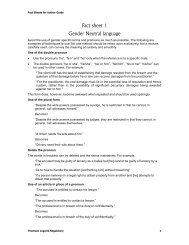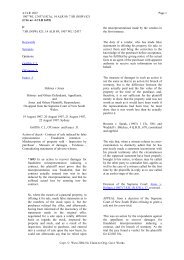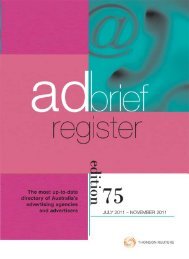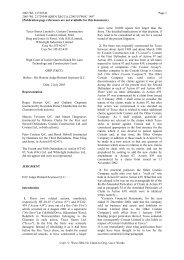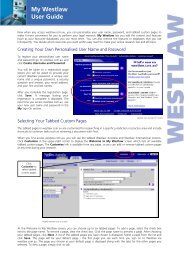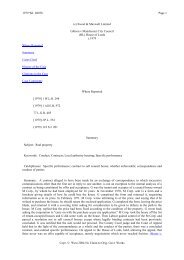Chapter 23: Product Liability - Thomson Reuters
Chapter 23: Product Liability - Thomson Reuters
Chapter 23: Product Liability - Thomson Reuters
You also want an ePaper? Increase the reach of your titles
YUMPU automatically turns print PDFs into web optimized ePapers that Google loves.
Strict <strong>Liability</strong> 156negligence, despite the pretence that strict liability focuses on the product, notthe producer and its role in the design process. 190Presumably exempt are generically “unavoidably unsafe” products, such asalcoholic beverages, butter, 191 drugs and even asbestos. These containirreducible risks and cannot be charged with design defect because they cannotbe made safer. Such products can, however, be regarded as “defective” ifsuitable warnings do not accompany their distribution. 192On its face the consumer expectation standard does not appear to makeallowance for any distinction between manufacturing and design/warningdefects. Whether or not an attenuated standard for the latter category wouldhave developed anyway, as occurred in the United States, strict liability isexpressly mitigated for design defects 193 by the so-called development risks or“state of the art” defence. The producer may show that “the state of scientific ortechnical knowledge at the time when the goods were supplied by theirmanufacturer was not such as to enable that safety defect to be discovered”. 194This defence limits liability to foreseeable risks as determined not by hindsight,but by knowledge prevailing when the product was put into circulation. 195 Itthus covers not only unforeseeable risks but also undiscoverable defects, such asblood plasma infected with serum hepatitis. This wide-ranging exclusion, ofspecial significance to the pharmaceutical industry, 196 has been criticised as abetrayal of the compensation objective and of the claim that the liability is notconduct-based. 197 It is defended on the ground that otherwise the marketing ofnovel products would be inhibited and because insurance would be unavailable.In the upshot, the fault standard has largely survived in relation to defectivedesign and failure to warn cases, except that the burden of proof is reversed. 198Finally, failure to warn of the risks may make a product defective. 199Warnings may either reduce risks or help potential users to make an “informedchoice”. Unavoidably dangerous products, like drugs with dangerous sideeffects, and other products which cannot be made safer but are sufficientlyDRAFT190 See Owen, “Defectiveness Restated: Exploding the “Strict” <strong>Product</strong>s <strong>Liability</strong> Myth” (1996)U Ill L Rev 743, a myth retained by Rest 3rd: <strong>Product</strong>s <strong>Liability</strong>, s 2.191 Rest 2d, s 402A cmt i.192 See Rest 3rd: <strong>Product</strong>s <strong>Liability</strong>, s 2, cmt c.193 Though not specifically stated, it has been assumed that the defence is not available formanufacturing defects: see BGH (1995 NJW 2162).194 AustralianConsumerLaw, s 142(c) (formerlyTradePracticesAct1974 (Cth), s 75AK(1)(c)),based on European Council Directive 85/374/EEC Art 7(e). See Newdick, “Risk, Uncertaintyand Knowledge in the Development Risk Defence” (1991) 20 Anglo-American L Rev 309.195 Reinforced by European Council Directive 85/374/EEC Art 6(2) and Australian ConsumerLaw, s 9(3) (formerly Trade PracticesAct 1974 (Cth), s 75AC(3)) (defect not to be inferredfrom the sole fact that a better product is subsequently marketed). See Newdick, “Risk,Uncertainty and Knowledge in the Development Risk Defence” (1991) 20 Anglo-Am L Rev309.196 See, for example, Peterson v Merck Sharpe & Dohme (Aust) Pty Ltd (2010) 266 ALR 1 at331-332, [926]-[930] per Jessup J (successful s 75AK(1)(c) (now s 142(c)) “start of the art”defence in relation to Vioxx; manufacturer’s own knowledge held to be the “state of theart”).197 Stapleton, “<strong>Product</strong> <strong>Liability</strong> Reform – Real or Illusory” (1986) 60 JLS 392;ThreeProblemswith the New <strong>Product</strong> <strong>Liability</strong>, in “Essays for Atiyah” (1991), ch 11; see also Beylereld &Brownsword, “Impossibility, Irrationality and Strict <strong>Product</strong> <strong>Liability</strong>” (1991) 20 Anglo-Am L Rev 257.198 See Newdick, “The Future of Negligence in <strong>Product</strong> <strong>Liability</strong>” (1987) 103 LQR 288.199 See, for example, Gliderol International Pty Ltd v Skerbic (2009) 170 ACTR 1 (CA)(defective instructions accompanying garage roller door).session: 5 October 28, 2010 page no: 21 folio no: 156@syd-tlrapp-p19/syd-tlrapp-p191/CLS_law/GRP_flemings/JOB_update10/DIV_19PROOF COPY



